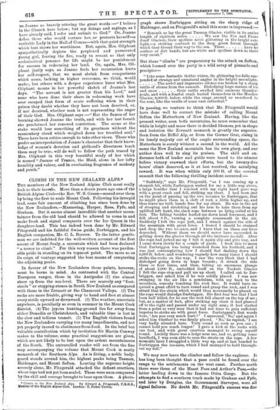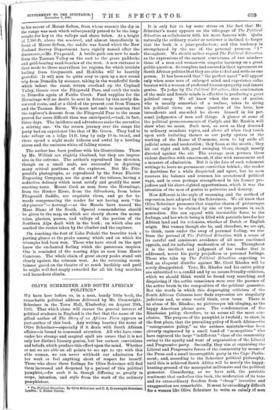CLIMBS IN THE NEW ZEALAND ALPS.*
THE members of the New Zealand Alpine Club must really look to their laurels. More than a dozen years ago one of the British Alpine Club—the Rev. W. S. Green—scored over them by being the first to scale Mount Cook. Following his intrepid lead, some fair amount of climbing has since been done by the New Zealanders,—Mannering, Harper, Ross, Fyfe, and Graham. But it seems almost incredible that another moun- taineer from the old land should be allowed to come in and make fresh and signal conquests over the Ice Queen in the daughter-land. This has indeed been done by Mr. Edward Fitzgerald and his faithful Swiss guide, Zurbriggen, and his English companion, Mr. 0. L. Barrow. To the latter gentle- man we are indebted for the well-written account of the first ascent of Mount Sealy, a mountain which had been declared "a terror to climb." For this very reason there was pardon- able pride in standing on its topmost point. The more so as its coign of vantage suggested the best means of conquering the adjoining peaks.
In favour of the New Zealanders these points, however, must be borne in mind. As contrasted with the Central European ranges, those in the Antipodes (1) rise almost sheer up from the sea-level. There are scarcely any " foot- stools " or stepping-stones in South New Zealand as compared with those in the Zermatt or the Chamouni Valleys. (2) The rocks are more friable, giving way to hand and foot at almost every stride upward or downward. (3) The weather, uncertain anywhere, is peculiarly so even in summer in the Mount Cook district. (4) The joyous hunting-ground lies far away from either Dunedin or Christchurch, and valuable time is lost in the slow and tedious transit. (5) The English visitors found the New Zealanders carrying too many impedimenta, and not yet properly inured to abstinence from food. In the brief but valuable contribution which by invitation Sir Martin Conway makes to the volume, some practical suggestions are given, which are not likely to be lost upon the ardent mountaineers of the South. The untravelled reader will see from the fine map accompanying the volume that Mount Cook is easily monarch of the Southern Alps. As is fitting, a noble body- guard stands around him, the highest peaks being Tasman, Haidenger, and Mount Sefton. Leaving the supreme height severely alone, Mr. Fitzgerald attacked the defiant courtiers, whose tops had not yet been scaled. These were soon conquered by the skill and courage brought to bear upon them. A photo-
• Climbs in the New Zealand Alps. By Edward A. Fitzgerald, F.R.G.S., Member of the English Alpine Club, Landon: T. Fisher Unwin.
graph shows Zurbriggen sitting on the sharp ridge of Haidenger, and on Fitzgerald's mind this scene is impressed :—
" Beneath us lay the great Tasmanwr Glacier, saw the ,loex in its entire z
length of eighteen miles
Josef Glaciers, their spotless neves glittering in the bright sun- light, —a striking contrast to the deep green forest through
which they thread their way to the sea. These have no surface or dirt bands, but are white and spotless down to their very snout."
But these " climbs " are preparatory to the attack on Sefton, which loomed over the party in a wild array of pinnacle and precipice— "Like some fantastic Gothic vision, its glittering ice-falls sus- pended at strange and unnatural angles in the bright moonlight.
The awful and impressive silence was broken by a sharp rattle of stones from the summit. Dislodging huge masses of ice
and snow their rattle swelled into ominous thunder- peals, and with a fearful crash buried themselves in the Mueller Glacier, 8,000 ft. below, while the crags around us re-echoed to the roar, like the vaults of some vast cathedral."
In passing, we venture to think that Mr. Fitzgerald would have done well to correct the mistake of calling Mount Sefton the Matterhorn of New Zealand. Having, like the present writer, seen both mountains, he must remember that while in height and mass there is decided likeness, yet in shape and isolation the Zermatt monarch is greatly the superior.
Seen from the Eiffel Alp, or from the Gorner Grat, rising in its lonely majesty out of the ample surrounding space, the Matterhorn is surely without a second in the world. All the same the New Zealand mountain has its own glory, and our author does well to sing its praises. The skill and en- durance both of leader and guide were taxed to the utmost before victory crowned their efforts, but the twenty-five hours' climb deserved, as it at last received, the satisfying reward. It was when within only 300 ft. of the coveted summit that the following thrilling incident occurred :—
" Suddenly," says Mr. Fitzgerald, "as I was coming up a steepish bit, while Zurbriggen waited for me a little way above, a large boulder that I touched with my right hand gave way with a great crash and fell, striking my chest. I had been just on the point of passing up the two ice-axes to Zurbriggen, that he might place them in a cleft of rock a little higher up, and thus leave me both bands free for my climb. He was in the act of stooping and stretching out his arm to take them from my uplifted left hand, the slack rope between us lying coiled at his feet. The falling boulder hurled me down head foremost, and I fell about 8 ft., turning a complete somersault in the air. Suddenly I felt the rope jerk, and I struck against the side of the mountain with great force. I feared I should be stunned and drop the two ice-axes, and I knew that on these our lives depended. Without them we should never have succeeded in getting down the glacier through all the intricate ice-fall. After the rope had jerked me up I felt it again slip and give way, and I came down slowly for a couple of yards. I took this to mean that Zurbriggen was being wrenched from his foothold, and I was just contemplating how I should feel dashing down the 6,000 ft. below, and wondering vaguely how many times I should strike the rocks on the way. I saw the very block that I had dislodged going down in huge bounds ; it struck the side three or four times, and then, taking an enormous plunge of about 2,000 ft., embedded itself on the Tucked Glacier I felt the rope stop and pull me up short. I called out to Zur- briggen, and asked him if he was solidly placed. I was now swinging in the air like a pendulum, with my back to the mountain, scarcely touching the rock face. It would have re- quired a great effort to turn round and grasp the rock, and I was afraid that the strain which would thus necessarily be placed on the rope Would dislodge Zurbriggen. His first fear was that I had been half killed, for he saw the rock fall almost on the top of me ; but, as a matter of fact, after striking my chest it had glanced off to the right and passed under my right arm; it had started from a point so very near that it had not time to gain sufficient impetus to strike me with great force. Zurbriggen's first words were, 'Are you very much hurt ? ' I answered, No,' and again I asked him whether he was firmly placed. No,' he replied, am very badly situated here. Turn round as soon as you can : I cannot hold you much longer.' I gave a kick at the rocks with one foot, and with great exertion managed to swing myself round. Luckily there was a ledge near me, and so, getting some handhold, I was soon able to ease the strain on the rope. A few Aso/ea/AS later I struggled a little way up, and at last handed to Zurbriggen the ice-axes, which I had managed to hold through- out my fall."
We may now leave the climber and follow the explorer. It has long been thought that a pass could be found over the range to the settlements on the west coast. Further north there were those of the Haast Pass and Arthur's Paas,—the latter leading down to the famous Otira Gorge. But the attempts to find a southern track made by Graham and Fyfe,
and later by Douglas, the Government Surveyor, were all signal failures. No doubt Mr. Fitzgerald's success was due to his ascent of Mount Sefton, from whose summit the din in the range was seen which subsequently proved to be the long- sought-for key to the valleys and shore below. At a height of 7,180 ft. above the sea-level, and almost immediately in front of Mount Sefton, the saddle was found which the New Zealand Survey Department have rightly named after the discoverer,—Mr. Fitzgerald. A bridle-path can now be made from the Tasman Valley on the east to the grass paddocks and gold-bearing sand-beaches of the west. A new entrance is thus made to these marvellous ice regions, for which tourists hailing from Greymouth and Hokitika will be heartily grateful. It will now be quite easy to open up a new round trip from Dunedin by steamer, taking in the wonderful fiords which indent the coast, return overland up the Copland Valley, thence over the Fitzgerald Pass, and catch the train to Dunedin again at Fairlie Creek. Food supplies for the Hermitage will no doubt be sent in future by this newly dis- covered route, and at a third of the present cost from Timarn and the Tasman River. We must not omit to mention that the explorer's descent from the Fitzgerald Pass to the ocean proved far more difficult than was anticipated,—took, in fact, three days. The incidents and adventures make the narrative a stirring one. On the return journey over the range the party had an experience like that of Mr. Green. They had to take refuge on a ledge 14 ft. long by only 18 in. broad, and there spend a night made hideous and awful by a howling storm and the ominous whizz of falling stones.
The author has been profuse with his illustrations. Those by Mr. Willink are slightly idealised, but they are impres- sive in the extreme. The author's reproduced line sketches, though on a small scale, are successful in depicting many critical positions of the explorers. But Mr. Fitz- gerald's photographs, as reproduced by the Swan Electric Engraving Company, are the gems of the volume, having a seductive delicacy which must satisfy and gratify the most exacting taste. Mount Cook as seen from the Hermitage, from the Hooker River, from the Silverhorn, from below Fitzgerald Saddle, are exquisite views, and go far to- wards compensating the reader for not having seen "the sky-piercer "— Aorangi — as the Maoris have named the Mont Blanc of the South. Special commendation should be given to the map, on which are clearly shown the moun- tains, glaciers, passes, and valleys of the portion of the Southern Alps dealt with in the book ; on which also are marked the routes taken by the climber and the explorer.
On reaching the foot of Lake Pukaki the traveller took a parting glance at the peaks among which and on which his triumphs had been won. Those who have stood on the spot know the enchanted feeling which the panorama inspires. One is reminded of the soaring Alps as seen from Monte Generoso. The whole chain of great snowy peaks stand out clearly against the crimson west. As the returning moun- taineer gazed on the theatre of so much hardship and peril he might well feel amply rewarded for all his long marches and hazardous climbs.



















































 Previous page
Previous page